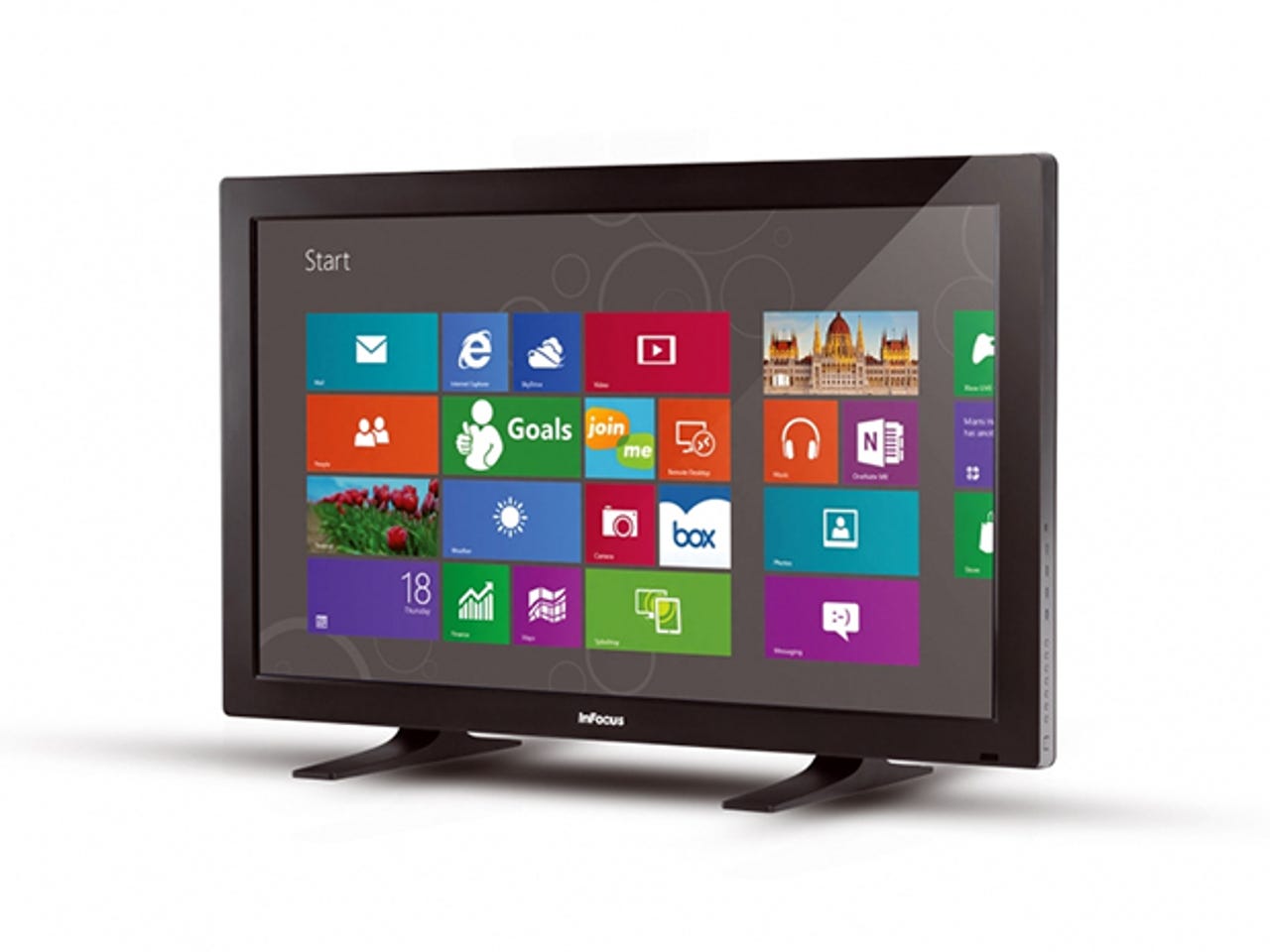InFocus BigTouch review


InFocus BigTouch
The BigTouch from projector specialist InFocus is aptly named: it's a big (very big) all-in-one touchscreen PC running Windows 8 Pro — and it'll also touch your wallet in a big way, as it costs £2,999 (ex. VAT; £3,599 inc. VAT) or $4,999 in the US. Aimed at classrooms, hospitals, hotel lobbies, swanky boardrooms and the like, the 55-inch BigTouch has a certain appeal where something more imposing (and less removeable) than a notebook and a projector is required. However, although it's an impressive system in many ways, the price tag will restrict the BigTouch's appeal to more well-heeled organisations for the moment.
Design
Did we mention the BigTouch's size? Big hardly does it justice: built around a 55-inch LCD, this gargantuan AIO system measures 134.6cm wide by 82cm high by 14cm deep (53in. x 32.3in. x 5.5in.) and weighs 55kg (122.4lb). It's a challenging lift even for two people.
Design-wise the BigTouch is businesslike, with the screen and PC components mounted in a slate-grey, silver-edged chassis, standing on a pair of large feet that keep the hefty unit reasonably steady. There are six USB 2.0 ports in all, two on the removable PC unit at the back and four on the right-hand side of the monitor. There's also a USB Type B port above the four Type A ports on the right side. Below the USB ports are the controls — seven of them — for the monitor's on-screen menu system, plus the power button. The PC unit housing the CPU, RAM, storage and Wi-Fi modules is secured at the back by a pair of (quite fiddly to remove and replace) screws and has two Gigabit Ethernet (RJ-45) connectors in addition to its pair of USB ports. Below the removeable unit are the video inputs — HDMI (x2), VGA, component, composite and S-Video, plus RCA stereo audio in and out connectors and 3.5mm audio in and out jacks.
The 55-inch LCD screen is big, but not particularly high-resolution at 1,920 by 1,080 pixels, which makes for relatively large (0.63mm) pixels that are visible up close, and low pixel density (40ppi). Of course, this screen is designed for communal rather than close viewing, so it's bright, with good (178-degree) viewing angles in both horizontal and vertical planes and has a matte anti-glare finish. Its 5-point touch functionality, provided by four edge-mounted cameras, works smoothly and provides a good platform for interactive presentations or information display applications.
We reviewed the 'basic' BigTouch, but a more expensive variant, which InFocus calls the Mondopad (the company insists on comparing this giant system to a tablet), is available. The Mondopad upgrade adds a 720p HD webcam with an integrated 4-microphone array, a 25W/channel sound bar containing a set of stereo speakers (including tweeters) and a collection of whiteboard and collaboration apps, plus a couple of mobile apps (Mondopad Connect and ControlView).
Features
The BigTouch's CPU is a second-generation (2-core/4-thread) Intel Core i5-2520M running at 2.5GHz (up to 3.2GHz in Turbo mode). Graphics are handled by the CPU-integrated HD Graphics 3000 GPU, there's 4GB of DDR3 RAM and the operating system is Windows 8 Pro.
Storage is provided by a 120GB Intel 520 Series SATA III (6Gbps) solid-state drive with claimed sequential read and write rates of 550MB/s and 500Mb/s respectively. There's no flash card slot, so if you want to add storage capacity you'll have to use a USB stick, network storage or a cloud-based service.
Networking is taken care of by two Gigabit Ethernet ports and dual-band (2.4GHz/5GHz) 802.11a/b/g/n Wi-Fi.
Performance & power consumption
The BigTouch's Windows Experience Index (WEI) of 5.5 (out of 7.9) is determined by the lowest-performing subsystem, which is Graphics (Desktop graphics performance). The remaining scores, in ascending order, are Memory (RAM) (Memory operations per second) with 5.9, Gaming Graphics (3D business and gaming graphics performance) with 6.2, Processor (Calculations per second) with 7.2 and Primary hard disk (Disk data transfer rate) with 7.6:
Using the demanding synthetic Cinebench 11.5 benchmark, we find similar OpenGL scores from the BigTouch with integrated HD Graphics 4000 and Dell's OptiPlex 9010 AIO also with integrated Intel graphics — in this case the HD Graphics 2500. The OptiPlex's faster (3.0GHz) third-generation Core i5 processor and 8GB of RAM give it the edge over the BigTouch in the CPU test:
We measured the performance of the 120GB Intel SSD using the ATTO disk benchmark, which reported reads at up to 269.5MB/s and writes at 140MB/s. That's well short of Intel's headline 550MB/s and 500MB/s speeds, but still enough to earn the BigTouch a 7.2/7.9 WEI subscore for Primary hard disk:
Although the BigTouch's specification isn't exactly earth-shattering, a 55in. LCD is going to chew through a fair amount of power — especially if you ramp up the brightness. To discover just how much, we measured power consumption using a Voltcraft VC940 Plus voltmeter under a variety of idle/load and screen brightness combinations:
With the screen brightness at 50 percent, power consumption is high but not excessive at 177W under load (running Cinebench 11.5 in this case). However, the wattage increases dramatically if you turn the brightness up full — 311W when idling and 331W when under load.
Conclusion
The largest and heaviest all-in-one PC we've ever seen, the BigTouch may find a niche in some presentation, classroom or signage situations. Its specification is hardly cutting edge (although adequate for the tasks likely to be asked of it) and it consumes a lot of power with the brightness cranked up. However, the price is almost as eye-watering as the system when you try to lift it. In many situations, a laptop and a mid-range projector will prove a more cost-effective solution.